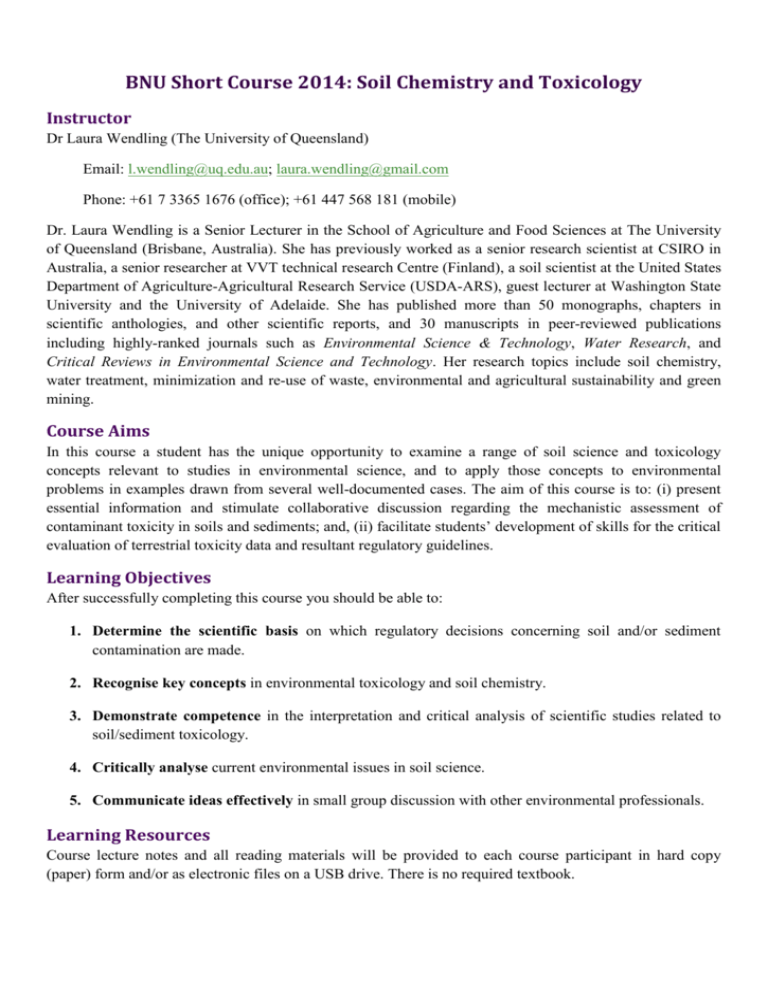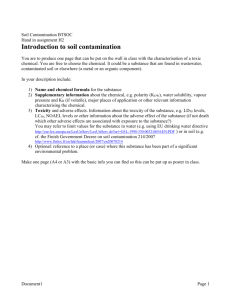BNU Short Course 2014: Soil Chemistry and Toxicology
advertisement

BNU Short Course 2014: Soil Chemistry and Toxicology Instructor Dr Laura Wendling (The University of Queensland) Email: l.wendling@uq.edu.au; laura.wendling@gmail.com Phone: +61 7 3365 1676 (office); +61 447 568 181 (mobile) Dr. Laura Wendling is a Senior Lecturer in the School of Agriculture and Food Sciences at The University of Queensland (Brisbane, Australia). She has previously worked as a senior research scientist at CSIRO in Australia, a senior researcher at VVT technical research Centre (Finland), a soil scientist at the United States Department of Agriculture-Agricultural Research Service (USDA-ARS), guest lecturer at Washington State University and the University of Adelaide. She has published more than 50 monographs, chapters in scientific anthologies, and other scientific reports, and 30 manuscripts in peer-reviewed publications including highly-ranked journals such as Environmental Science & Technology, Water Research, and Critical Reviews in Environmental Science and Technology. Her research topics include soil chemistry, water treatment, minimization and re-use of waste, environmental and agricultural sustainability and green mining. Course Aims In this course a student has the unique opportunity to examine a range of soil science and toxicology concepts relevant to studies in environmental science, and to apply those concepts to environmental problems in examples drawn from several well-documented cases. The aim of this course is to: (i) present essential information and stimulate collaborative discussion regarding the mechanistic assessment of contaminant toxicity in soils and sediments; and, (ii) facilitate students’ development of skills for the critical evaluation of terrestrial toxicity data and resultant regulatory guidelines. Learning Objectives After successfully completing this course you should be able to: 1. Determine the scientific basis on which regulatory decisions concerning soil and/or sediment contamination are made. 2. Recognise key concepts in environmental toxicology and soil chemistry. 3. Demonstrate competence in the interpretation and critical analysis of scientific studies related to soil/sediment toxicology. 4. Critically analyse current environmental issues in soil science. 5. Communicate ideas effectively in small group discussion with other environmental professionals. Learning Resources Course lecture notes and all reading materials will be provided to each course participant in hard copy (paper) form and/or as electronic files on a USB drive. There is no required textbook. Policies and Guidelines Course policies and guidelines regarding academic integrity, plagiarism, and feedback on assessment will be consistent with the standard policies and guidelines of Beijing Normal University. Course Schedule and Learning Activities Date 28/4 Duration 08:00-10:00 14:30-16:30 29/4 08:00-10:00 14:30-16:30 30/4 10:00-12:00 14:30-16:30 1/5 2/5 3/5 4/5 Content Activity Introduction to environmental toxicology Toxicological concepts and dose-response relationships Adsorption, distribution and storage of toxicants DISCUSSION In-class problem solving: dose-response curves, estimation of LDs, TDs, & ECs Environmental toxicants Linking toxicological concepts with soil chemistry Soil mineralogy DISCUSSION In class discussion: how do soil minerals alter toxicity? Development of surface charge Surface charge effects DISCUSSION In-class problem solving (short answer questions) No lectures 1-3 May 10:00-11:00 14:30-16:30 Organic matter in soils DISCUSSION 5/5 08:00-10:00 5/5 14:30-16:30 Sources of inorganic contaminants Fate and behaviour of inorganic contaminants Trace element toxicity in agriculture: soil-to-plant transfer of contaminants Discussion 6/5 08:00-10:00 14:00-15:00 7/5 Assignment Assignment 1: 10 short answer & multiple choice questions. Hand in on Monday 5 May 10:00-12:00 Remediation of metal contaminated soils Sources of organic contaminants Fate and behaviour of organic contaminants Remediation of organic contaminants in soils In-class problem solving (short answer questions) Assignment 2: 4 short answer & 6 multiple choice questions. Hand in on Wednesday 7 May Cadmium in rice: inclass discussion Short reading related to Love Canal Case study & in-class discussion: Love Canal 8/5 8/5 9/5 14:30-16:30 08:00-10:00 14:30-16:30 10:00-12:00 Introduction to risk assessment Group discussion Summary and review session Group discussion Assessment Exam: Short answer and multiple choice (~40 questions) Assessment Course assessment will be comprised of: demonstration of critical analysis during in-class discussions (20%); assignment 1 (20%); assignment 2 (20%); and a final exam (40%).







